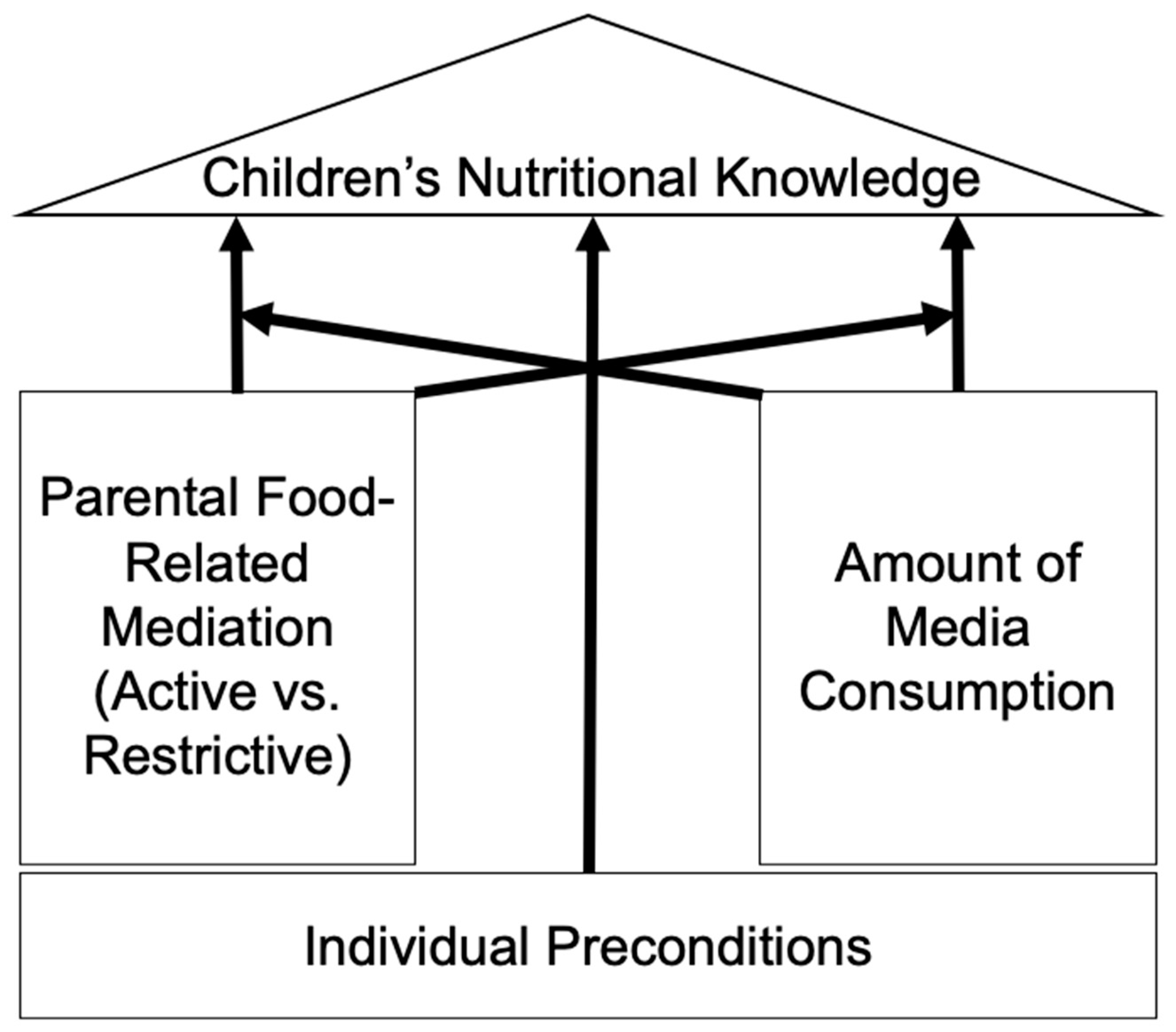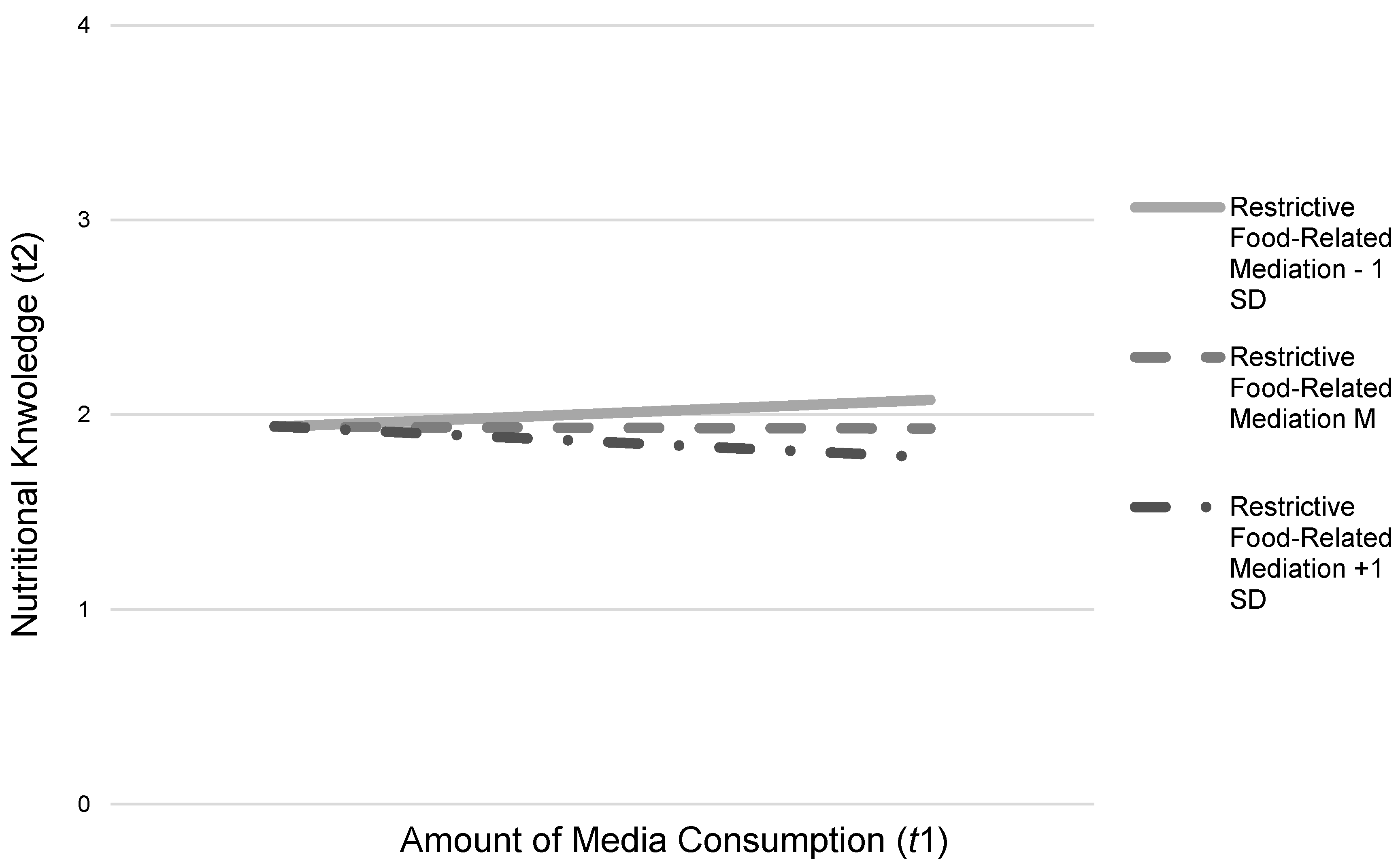Fiction is Sweet. The Impact of Media Consumption on the Development of Children’s Nutritional Knowledge and the Moderating Role of Parental Food-Related Mediation. A Longitudinal Study
Abstract
1. Introduction
2. Materials and Methods
2.1. Participants
2.2. Measures
2.3. Data Analysis
3. Results
3.1. Amount of Media Consumption
3.2. Parental Food-Related Mediation Strategies
3.3. Individual Preconditions
4. Discussion
5. Conclusions
Author Contributions
Funding
Conflicts of Interest
Appendix A
Appendix A.1. Nutritional Knowledge Test Items: Wave 1
| Item 1: Which One Has the Lowest Amount of Fat? | |||||
| Cookie | Cucumber (correct answer) | French fries | Coconut | Cheese | Don’t know |
| Item 2: Which One Has the Highest Amount of Sugar? | |||||
| Fruit juice | Banana | Cola (correct answer) | Muffin | Apple | Don’t know |
| Item 3: Which One Has the Lowest Amount of Salt? | |||||
| Potato chips | Bread | Cucumber (correct answer) | 2 Oreo cookies | French fries | Don’t know |
Appendix A.2. Nutritional Knowledge Test Items: Wave 2
| Item 1: Which One Has the Lowest Amount of Fat? | |||||
| Coconut | Yoghurt with fruits | Orange (correct answer) | Granola bar | Pizza | Don’t know |
| Item 2: Which One Has the Highest Amount of Sugar? | |||||
| Fanta (correct answer) | Grapes | Cake | Coconut | Mineral with raspberry flavor | Don’t know |
| Item 3: Which One Has the Lowest Amount of Salt? | |||||
| Cake | Pizza | Popcorn | Orange (correct answer) | Bread | Don’t know |
Appendix A.3. Measures Parental Food-Related Mediation
| Restrictive food-related Mediation | I follow clear rules and restrictions on what my child is allowed to eat. I tell my child how much to eat of certain foods. I forbid my child to eat certain foods. |
| Active food-related Mediation | I talk to my child about why a food is healthy or unhealthy. I talk to my child about the consequences of unhealthy eating behavior. I instruct my child during the meal on which foods are healthy. |
References
- Roberts, M.; Pettigrew, S. A thematic content analysis of children’s food advertising. Int. J. Advert. 2007, 26, 357–367. [Google Scholar] [CrossRef]
- Jenkin, G.; Madhvani, N.; Signal, L.; Bowers, S. A systematic review of persuasive marketing techniques to promote food to children on television: Persuasive TV food marketing to children. Obes. Rev. 2014, 15, 281–293. [Google Scholar] [CrossRef] [PubMed]
- Castonguay, J.; McKinley, C.; Kunkel, D. Health-related messages in food advertisements targeting children. Health Educ. 2013, 113, 420–432. [Google Scholar] [CrossRef]
- Kelly, B.; King, L.; Baur, L.; Rayner, M.; Lobstein, T.; Monteiro, C.; Macmullan, J.; Mohan, S.; Barquera, S.; Friel, S.; et al. Monitoring food and non-alcoholic beverage promotions to children: Monitoring food promotions to children. Obes. Rev. 2013, 14, 59–69. [Google Scholar] [CrossRef] [PubMed]
- Keller, S.K.; Schulz, P.J. Distorted food pyramid in kids programmes: A content analysis of television advertising watched in Switzerland. Eur. J. Public Health 2011, 21, 300–305. [Google Scholar] [CrossRef] [PubMed]
- Araque-Padilla, R.; Villegas-Navas, V.; Montero-Simo, M.-J. Non-branded food placements in children’s entertainment programs: A content analysis. Health Commun. 2019, 34, 1222–1229. [Google Scholar] [CrossRef] [PubMed]
- Speers, S.E.; Harris, J.L.; Schwartz, M.B. Child and adolescent exposure to food and beverage brand appearances during Prime-Time television programming. Am. J. Prev. Med. 2011, 41, 291–296. [Google Scholar] [CrossRef]
- Matthes, J.; Naderer, B. Sugary, fatty, and prominent: Food and beverage appearances in children’s movies from 1991 to 2015. Pediatric Obes. 2019, 14, 1–7. [Google Scholar] [CrossRef]
- Halford, J.C.G.; Gillespie, J.; Brown, V.; Pontin, E.E.; Dovey, T.M. Effect of television advertisements for foods on food consumption in children. Appetite 2004, 42, 221–225. [Google Scholar] [CrossRef]
- Charry, K.M. Product placement and the promotion of healthy food to pre-adolescents: When popular TV series make carrots look cool. Int. J. Advert. 2014, 33, 599–616. [Google Scholar] [CrossRef]
- Naderer, B.; Matthes, J.; Binder, A.; Marquart, F.; Mayrhofer, M.; Obereder, A.; Spielvogel, I. Shaping children’s healthy eating habits with food placements? Food placements of high and low nutritional value in cartoons, Children’s BMI, food-related parental mediation strategies, and food choice. Appetite 2018, 120, 644–653. [Google Scholar] [CrossRef] [PubMed]
- Fuller-Tyszkiewicz, M.; Skouteris, H.; Hardy, L.L.; Halse, C. The associations between TV viewing, food intake, and BMI. A prospective analysis of data from the Longitudinal Study of Australian Children. Appetite 2012, 59, 945–948. [Google Scholar] [CrossRef] [PubMed]
- World Health Organization. WHO Obesity and Overweight. Factsheet June 2016. 2016. Available online: http://www.who.int/mediacentre/factsheets/fs311/en/ (accessed on 15 January 2020).
- Phipps, S.; Burton, P.; Lethbridge, L.; Osberg, L. Measuring Obesity in Young Children. Can. Public Policy/Anal. De Polit. 2004, 30, 349. [Google Scholar] [CrossRef]
- Shunk, J.A.; Birch, L.L. Girls at risk for overweight at age 5 are at risk for dietary restraint, disinhibited overeating, weight concerns, and greater weight gain from 5 to 9 years. J. Am. Diet. Assoc. 2004, 104, 1120–1126. [Google Scholar] [CrossRef]
- Rathi, N.; Riddell, L.; Worsley, A. Parents’ and teachers’ critique of nutrition education in Indian secondary schools. Health Educ. 2019, 119, 150–164. [Google Scholar] [CrossRef]
- Sherman, J.W.; Gawronski, B.; Gonsalkorale, K.; Hugenberg, K.; Allen, T.J.; Groom, C.J. The self-regulation of automatic associations and behavioral impulses. Psychol. Rev. 2008, 115, 314–335. [Google Scholar] [CrossRef]
- Harrison, K. Is “Fat Free” good for me? A panel study of television viewing and children’s nutritional knowledge and reasoning. Health Commun. 2005, 17, 117–132. [Google Scholar] [CrossRef]
- Worsley, A. Nutrition knowledge and food consumption: Can nutrition knowledge change food behaviour? Asia Pac. J. Clin. Nutr. 2002, 11, S579–S585. [Google Scholar] [CrossRef]
- Rathi, N.; Riddell, L.; Worsley, A. Food and nutrition education in private Indian secondary schools. Health Educ. 2017, 117, 193–206. [Google Scholar] [CrossRef]
- Elliott, C.; Brierley, M. Healthy Choice?: Exploring How Children Evaluate the Healthfulness of Packaged Foods. Can. J. Public Health 2012, 103, e453–e458. [Google Scholar] [CrossRef]
- Choi, H.; Paek, H.-J.; Whitehill King, K. Are nutrient-content claims always effective?: Match-up effects between product type and claim type in food advertising. Int. J. Advert. 2012, 31, 421–443. [Google Scholar] [CrossRef]
- Dixon, H.; Scully, M.; Niven, P.; Kelly, B.; Chapman, K.; Donovan, R.; Martin, J.; Baur, L.A.; Crawford, D.; Wakefield, M. Effects of nutrient content claims, sports celebrity endorsements and premium offers on pre-adolescent children’s food preferences: Experimental research: Child responses to food pack promotions. Pediatric Obes. 2014, 9, 47–57. [Google Scholar] [CrossRef]
- Harris, J.L.; Haraghey, K.S.; Lodolce, M.; Semenza, N.L. Teaching children about good health? Halo effects in child-directed advertisements for unhealthy food: Halo effects in children’s food advertising. Pediatric Obes. 2018, 13, 256–264. [Google Scholar] [CrossRef] [PubMed]
- Soldavini, J.; Crawford, P.; Ritchie, L.D. Nutrition Claims Influence Health Perceptions and Taste Preferences in Fourth- and Fifth-Grade Children. J. Nutr. Educ. Behav. 2012, 44, 624–627. [Google Scholar] [CrossRef]
- Birch, L.L.; Fisher, J.O.; Grimm-Thomas, K.; Markey, C.N.; Sawyer, R.; Johnson, S.L. Confirmatory factor analysis of the Child Feeding Questionnaire: A measure of parental attitudes, beliefs and practices about child feeding and obesity proneness. Appetite 2001, 36, 201–210. [Google Scholar] [CrossRef] [PubMed]
- Birch, L.L.; Marlin, D.W. I don’t like it; I never tried it: Effects of exposure on two-year-old children’s food preferences. Appetite 1982, 3, 353–360. [Google Scholar] [CrossRef]
- Borzekowski, D.L.G.; Robinson, T.N. The 30-Second Effect. J. Am. Diet. Assoc. 2001, 101, 42–46. [Google Scholar] [CrossRef]
- Buijzen, M.; Valkenburg, P.M. Parental mediation of undesired advertising effects. J. Broadcast. Electron. Media 2005, 49, 153–165. [Google Scholar] [CrossRef]
- Lwin, M.O.; Shin, W.; Yee, A.Z.H.; Wardoyo, R.J. A Parental Health Education Model of Children’s Food Consumption: Influence on Children’s Attitudes, Intention, and Consumption of Healthy and Unhealthy Foods. J. Health Commun. 2017, 22, 403–412. [Google Scholar] [CrossRef]
- Reinehr, T.; Kersting, M.; Chahda, C.; Andler, W. Nutritional knowledge of obese compared to non obese children. Nutr. Res. 2003, 23, 645–649. [Google Scholar] [CrossRef]
- Childhood Obesity Surveillance Initiative (COSI). Bericht Österreich 2017. 2017. Available online: https://www.sozialministerium.at/Themen/Gesundheit/Kinder--und-Jugendgesundheit/COSI.html (accessed on 18 May 2020).
- Feierabend, S.; Plankenhorn, T.; Rathgeb, T. KIM-Studie 2016 Kindheit, Internet, Medien. Basisuntersuchung Zum Medien; Medienpädagogischer Forschungsverbund Südwest (mpfs): Stuttgart, Germany, 2016. [Google Scholar]
- De Decker, A.; Sioen, I.; Verbeken, S.; Braet, C.; Michels, N.; De Henauw, S. Associations of reward sensitivity with food consumption, activity pattern, and BMI in children. Appetite 2016, 100, 189–196. [Google Scholar] [CrossRef] [PubMed]
- Tarabashkina, L.; Quester, P.; Crouch, R. Exploring the moderating effect of children’s nutritional knowledge on the relationship between product evaluations and food choice. Soc. Sci. Med. 2016, 149, 145–152. [Google Scholar] [CrossRef] [PubMed]
- Hayes, A.F. Introduction to Mediation, Moderation, and Conditional Process Analysis: A Regression-Based Approach; Guilford Publications: New York, NY, USA, 2013. [Google Scholar]
- Naderer, B.; Matthes, J.; Marquart, F.; Mayrhofer, M. Children’s attitudinal and behavioral reactions to product placements: Investigating the role of placement frequency, placement integration, and parental mediation. Int. J. Advert. 2018, 37, 236–255. [Google Scholar] [CrossRef]
- Matthes, J. Need for Orientation as a Predictor of Agenda-Setting Effects: Causal Evidence from a Two-Wave Panel Study. Int. J. Public Opin. Res. 2008, 20, 440–453. [Google Scholar] [CrossRef]
- Scharkow, M. The Reliability and Temporal Stability of Self-reported Media Exposure: A Meta-analysis. Commun. Methods Meas. 2019, 13, 198–211. [Google Scholar] [CrossRef]


| Full Model: Main & Interaction Effects. | β | SE | p-Value |
|---|---|---|---|
| Step 1: Individual Preconditions | |||
| Child Age | 0.18 | 0.03 | <0.001 |
| Child BMIz a | −0.01 | 0.03 | 0.726 |
| Child Sex | 0.01 | 0.06 | 0.870 |
| Nutritional Knowledge (t1) | 0.32 | 0.04 | <0.001 |
| Step 2: Agents of Knowledge | |||
| Amount of Media Consumption | −0.11 | 0.05 | 0.003 |
| Active Food-Related Mediation | 0.05 | 0.02 | 0.232 |
| Restrictive Food-Related Mediation | −0.02 | 0.02 | 0.694 |
| Step 3: Interaction Effects | |||
| Amount of Media Consumption × Active Food-Related Mediation | −0.01 | 0.04 | 0.866 |
| Amount of Media Consumption × Restrictive Food-Related Mediation | −0.10 | 0.03 | 0.017 |
| R2 | 18.40% | ||
© 2020 by the authors. Licensee MDPI, Basel, Switzerland. This article is an open access article distributed under the terms and conditions of the Creative Commons Attribution (CC BY) license (http://creativecommons.org/licenses/by/4.0/).
Share and Cite
Binder, A.; Naderer, B.; Matthes, J.; Spielvogel, I. Fiction is Sweet. The Impact of Media Consumption on the Development of Children’s Nutritional Knowledge and the Moderating Role of Parental Food-Related Mediation. A Longitudinal Study. Nutrients 2020, 12, 1478. https://doi.org/10.3390/nu12051478
Binder A, Naderer B, Matthes J, Spielvogel I. Fiction is Sweet. The Impact of Media Consumption on the Development of Children’s Nutritional Knowledge and the Moderating Role of Parental Food-Related Mediation. A Longitudinal Study. Nutrients. 2020; 12(5):1478. https://doi.org/10.3390/nu12051478
Chicago/Turabian StyleBinder, Alice, Brigitte Naderer, Jörg Matthes, and Ines Spielvogel. 2020. "Fiction is Sweet. The Impact of Media Consumption on the Development of Children’s Nutritional Knowledge and the Moderating Role of Parental Food-Related Mediation. A Longitudinal Study" Nutrients 12, no. 5: 1478. https://doi.org/10.3390/nu12051478
APA StyleBinder, A., Naderer, B., Matthes, J., & Spielvogel, I. (2020). Fiction is Sweet. The Impact of Media Consumption on the Development of Children’s Nutritional Knowledge and the Moderating Role of Parental Food-Related Mediation. A Longitudinal Study. Nutrients, 12(5), 1478. https://doi.org/10.3390/nu12051478






